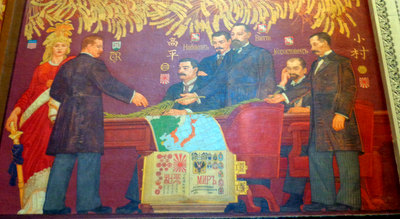Treaty of Portsmouth
- Signed: 5 September 1905
- Japanese: ポーツマス条約 (Pootsumasu jôyaku)
The Treaty of Portsmouth, signed on 5 September 1905 at the Portsmouth Naval Yard in Maine (USA), marked the end of the Russo-Japanese War. President Theodore Roosevelt of the United States served as the primary mediator between Japanese Foreign Minister Komura Jutarô[1] and his Russian counterparts.
In the terms of the treaty, Russia recognized Japan’s dominant political, economic, and military position in Korea; ceded the southern portion of Sakhalin to Japan; transferred railroad rights and other privileges in Manchuria to Japan; and transferred a lease on the southern part of Liaodong peninsula to Japan.
Aftermath
Theodore Roosevelt was granted the Nobel Peace Prize for his role in mediating the peace.
The people of Tokyo, upset at the peace conditions, rioted in protest. In what was perhaps the first major urban riot of the Meiji period, citizens set fire to the prime minister's residence, electric streetcars, and police boxes.[2]
Japan soon afterwards headquartered an army group in Port Arthur which came to be called the Guandong (or Kwantung) Army, as well as the South Manchurian Railway Company, both of which would play key roles in initiating the outbreak of hostilities in the 1930s which then expanded into the full-on Fifteen-Years War (also known as the Second Sino-Japanese War, the Chinese/continental portion of the Pacific War).
References
- Okinawa ken heiwa kinen shiryôkan sôgô annai 沖縄県平和祈念資料館総合案内 ("General Catalog of Okinawa Peace Memorial Museum"), Nanjô, Okinawa: Okinawa Peace Memorial Museum (2004), 22.
- ↑ Marius Jansen, "Japanese Imperialism: Late Meiji Perspectives," in Mark Peattie (ed.), The Japanese Colonial Empire, 1895-1945, Princeton University Press (1984), 69.
- ↑ Anne Walthall, "Nishimiya Hide: Turning Palace Arts into Marketable Skills," in Walthall (ed.), The Human Tradition in Modern Japan," Scholarly Resources, Inc. (2002), 59.
